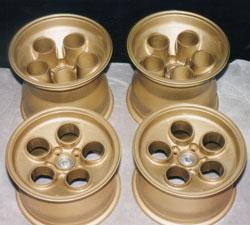- FMA
- The Fabricator
- FABTECH
- Canadian Metalworking
Advancing Automotive Research
- June 1, 2009
- Article
- Management

These magnesium cast wheels are an example of part production from lighter-weight material in today's cars.
In April the federal government announced the establishment of an automotive research fund designed to keep the Canadian auto industry competitive and sustainable.
The program will support R&D projects in specific areas, including alternative fuels, next-generation manufacturing, advanced power trains, and lighter or more sustainable materials. Proposals will be selected through rigorous, independent peer review.
“Automotive Partnership Canada will enhance our automotive research capacity, fueling made-in-Canada innovation, increasing our ability to compete internationally, and bringing long-term benefits to this important sector,” said Minister of Industry Tony Clement. “Our government is investing in research and development not only because it will lead to greener, better-performing vehicles, but because it will create jobs and strengthen the economy for future generations.”
Automotive Partnership Canada (APC) involves funding from the Natural Sciences and Engineering Research Council of Canada (NSERC), National Research Council Canada (NRC), Canada Foundation for Innovation (CFI), Social Sciences and Humanities Research Council of Canada (SSHRC), and Canada Excellence Research Chairs (CERC) program.
“Engaging industry to this extent will ensure that innovation moves quickly from the lab to the plant to the showroom,” said Dr. Suzanne Fortier, president of NSERC. “We want international automakers to realize that Canadians aren’t just good at building vehicles; we are a great place to conduct leading-edge R&D.”
About the APC
The APC is a five-year (2009–2014), $145 million initiative to support significant, collaborative, industry-driven research and development that benefits the Canadian automotive industry.
The APC will support R&D activities in the following areas:
- Lighter-weight or sustainable materials
- Advanced power train
- Energy storage
- Application of alternative fuels
- Vehicular software
- Electronics and mechatronics that enhance safety or performance
- Wired and wireless communications
- Manufacturing processes that reduce mass
- Manufacturing processes for cost reduction and quality improvement
- Improved manufacturing flexibility and efficiency
Reducing Vehicle Weight and Emissions
In March NSERC also announced funding for seven strategic research networks, including the Magnesium Network (MagNet) hosted by the University of British Columbia. Under the direction of materials engineering professor Warren Poole, MagNet connects a team from industry, government, and five Canadian universities to focus on reducing vehicle weight using wrought magnesium alloys.
The density of magnesium is 75 percent lower than steel’s and 33 percent lower than aluminum’s. By extensive use of magnesium components in an automobile, automakers could reduce the net weight of an average car or light truck by 20 to 25 percent, according to research at MagNet. It is estimated that a 10 percent reduction in vehicle weight increases fuel economy by 6 to 8 percent, and each kilogram of weight reduction leads to a reduction of 17 to 20 kg of carbon dioxide over the life of a vehicle. Furthermore, magnesium technology is viewed by industry as a key enabling technology of the next generation of electric, hybrid, or fuel cell vehicles.
“Our government supports science and technology because it creates jobs, improves Canadians' quality of life, and strengthens the economy for future generations,” said Gary Goodyear, minister of state (science and technology), when making the funding announcement. “These projects will increase research and training in areas that will benefit Canadians, such as the economy, the environment, biotechnology, and sustainable energy.”
MagNet will receive $4.8 million in NSERC funding and $0.425 million from industry over five years.
“The NSERC and industry funding will enable us to establish Canada as a world leader in magnesium technology. Our team will work with the automotive industry to develop the knowledge necessary to produce magnesium components, and to transfer this knowledge base to Canadian industry. In addition, it will allow us to educate many highly skilled engineers and scientists,” said Poole. “As researchers involved with this project and as citizens dedicated to a cleaner future, we are extremely grateful to NSERC and to taxpayers for funding this initiative.”
In addition to a team of researchers from the University of British Columbia, the MagNet network includes researchers from École Polytechnique, McGill University, McMaster University, and the University of Waterloo.
subscribe now


Keep up to date with the latest news, events, and technology for all things metal from our pair of monthly magazines written specifically for Canadian manufacturers!
Start Your Free Subscription- Trending Articles
- Industry Events
CTMA Economic Uncertainty: Helping You Navigate Kitchener Seminar
- May 2, 2024
- Kitchener, ON Canada
Automate 2024
- May 6 - 9, 2024
- Chicago, IL
ANCA Open House
- May 7 - 8, 2024
- Wixom, MI
17th annual Joint Open House
- May 8 - 9, 2024
- Oakville and Mississauga, ON Canada
MME Saskatoon
- May 28, 2024
- Saskatoon, SK Canada















